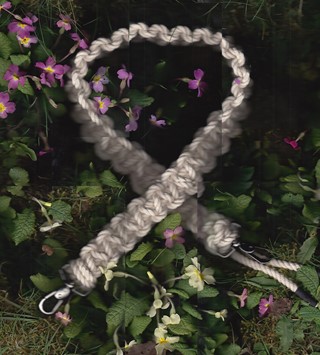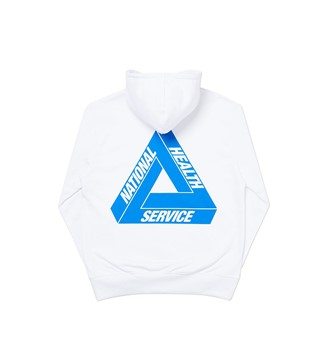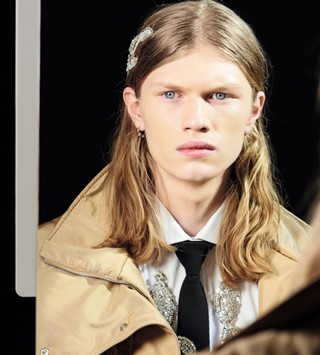Westminster graduate William Dill-Russell says he’s ‘challenging my own identity issues through clothing’
- TextBen Perdue
Up Next is a new column taking a closer look at some of fashion’s rising stars.
Name: William Dill-Russell
Location: London
Alma Mata: University of Westminster
USP: Sculptural, dark and dramatic clothing.
Instagram: @william_dill_russell
“Every week my understanding of gender changes,” says William Dill-Russell. “I’m challenging my own identity issues through clothing, when really I should sit down and work out what’s going on with me first. But why put that pressure on myself? Will I ever have time to sort it out? Probably not, and that’s what scares me most.” Frank to a fault, the self-styled non-binary designer explores gender through silhouettes, drawing heavily on personal realisations to figure things out in a way that feels more sculptural than fashion. This is reflected in costume-like collections as dark as they are dramatic, generous in both proportion and embellishment with their puffed-up ruffles and piled-on pleats. An underlying ambiguity created by overlapping lavish couture elements with sharp tailoring, crafting forms that morph in and out of focus. Part theatrical; part sartorial – with one fishnet-stockinged foot firmly in the boudoir.
“A lot of it comes from me,” says Dill-Russell. “I walk very hunchbacked and rushed, and I’ve always got some big black thing on and look a bit mad. My Adam’s apple is covered and I wear loads of layers, because I don’t really know how comfortable I am with what’s underneath. So by taking that to the point at which you don’t know where the person ends and the clothing begins is just my reaction to a world ludicrously obsessed with bodies, and where you go to pee.”

For someone who hasn’t slept for 36 hours because they handed in their graduate collection at the University of Westminster this morning, the Wolverhampton-born 22-yr-old looks and sounds disarmingly sharp – red hair fresh from the salon, instead of the usual “box dye from Boots.” Growing up as a queer kid who wanted to dress up but was too uncomfortable going out to find clothes, Dill-Russell made them at home with the help of his nan who sold sewing machines. Then, when his family moved to a white middle-class town in Shropshire, he became stuck in an oppressively prescriptive education system that threw up a new set of creative challenges, overcome by exploring the internet. And his dad’s CD collection. “I discovered that he was really into Björk and The Prodigy. We listened to Smack My Bitch Up in the car to school.”
A foundation course at Central Saint Martins would have led to Dill-Russell completing a degree there too, if it hadn’t been for a first day experience from hell that inspired a transfer to Westminster. “The tutor ripped up my sketchbook in front of the class and said they couldn’t understand how I’d got into university. That was a fairly horrific mindfuck. They try to strip you down at CSM, and when you have existing mental health issues it’s not exactly a great approach.” Therein lies the disillusionment that balances Dill-Russell’s surreal silhouettes with a sense of realism, coming through in how he conceives and executes his collections. Working full-time for a year while designing in his downtime, he experienced firsthand how some brands treat their staff. “The humanity has disappeared. I’ve had a lovely team helping with my collection but I’m not going to keep them past half five because they have their own lives to lead, and they’re lending me their time. It’s ludicrous to think otherwise.”

Another example is London’s club scene, a heavy source of inspiration and casting ideas until queer culture was appropriated wholesale. “It’s become completely fabricated,” he says. “People are paid to be club kids in straight venues to make them seem cool. Club culture doesn’t really exist; it’s just a trend to make money. So now I find people on Instagram who intrigue me.” And characters are important, they lend each of Dill-Russell’s looks a personality, complete with its own name, like Discern, or Weltzschmerlz – a brilliant German word that means anxiety around feeling.
It’s his frustration at the public’s preoccupation with gender stereotypes, which are just a social construct after all, that drives the more extreme silhouettes – reactionary shapes that are almost mockingly ludicrous. “Even I hate them sometimes, and I have to take them home with me!” Harnessing that anger, and turning some of the casual discrimination aimed at the LGBTQ community back on its perpetrators, is what gives Dill-Russell his radical edge. “I’d love to look like one of those unapproachable women who are so glamorous it’s threatening. It relates to how queer and trans people are demonised because they’re perceived as a threat to the normal, patriarchal society, and I embrace that. It’s difficult always living in that situation, so being scary is good. Like, no one ever sits next to me on the tube, because they see I’ve got a hairy leg or something and drag their children away. But I don’t mind that. I always have somewhere to put my bag.”















